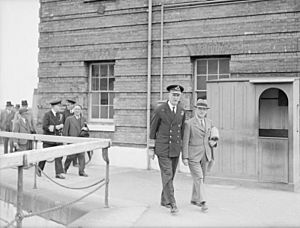George Isaacs facts for kids
Quick facts for kids
George Isaacs
JP DL
|
|
|---|---|

Isaacs with Admiral Charles Little in 1943
|
|
| Minister of Pensions | |
| In office 17 January 1951 – 5 November 1951 |
|
| Prime Minister | Clement Attlee |
| Preceded by | Hilary Marquand |
| Succeeded by | Derick Heathcoat-Amory |
| Minister of Labour and National Service | |
| In office 3 August 1945 – 17 January 1951 |
|
| Prime Minister | Clement Attlee |
| Preceded by | Rab Butler |
| Succeeded by | Aneurin Bevan |
| Member of Parliament for Southwark Southwark North (1929-31 and 1939–1950) |
|
| In office 19 May 1939 – 18 September 1959 |
|
| Preceded by | Edward Anthony Strauss |
| Succeeded by | Ray Gunter |
| In office 30 May 1929 – 7 October 1931 |
|
| Preceded by | Edward Anthony Strauss |
| Succeeded by | Edward Anthony Strauss |
| Member of Parliament for Gravesend |
|
| In office 6 December 1923 – 9 October 1924 |
|
| Preceded by | Alexander Richardson |
| Succeeded by | Irving Albery |
| Personal details | |
| Born | 28 May 1883 Finsbury, London |
| Died | 26 April 1979 (aged 95) |
| Political party | Labour |
George Alfred Isaacs (born May 28, 1883 – died April 26, 1979) was an important British politician and trade union leader. He was part of the government led by Clement Attlee.
Contents
George Isaacs: A Life in Politics
George Isaacs was born in Finsbury, a part of London. He came from a Methodist family. In 1905, he married Flora Beasley.
Early Life and Union Work
George Isaacs started his career as a printer. He quickly became involved in trade unions. These groups help workers get fair pay and good working conditions.
In 1909, he became the General Secretary of the National Society of Operative Printers and Assistants (NATSOPA). This was a big job, and he held it for 40 years! This role also meant he was part of the General Council of the Trades Union Congress (TUC). The TUC is a large group that represents many different trade unions in the UK. He was also active in the Labour Party, a political party that often supports workers' rights.
Becoming a Member of Parliament
George Isaacs also got involved in local politics in Southwark. He served as the Mayor of the Borough of Southwark from 1919 to 1921.
In 1923, he was elected as a Member of Parliament (MP) for Gravesend. An MP is someone elected to represent a specific area in the UK Parliament. He won by a very small number of votes. During this time, he worked as a special assistant to Jimmy Thomas, who was the Secretary of State for the Colonies.
However, George Isaacs lost his seat in the 1924 election. He tried again in 1927 for Southwark North but didn't win. He finally returned to Parliament in 1929, again representing Southwark North. Jimmy Thomas, now the Secretary of State for Dominion Affairs, once more chose him as his assistant.
In 1931, the Labour Party faced a big defeat, and George Isaacs lost his seat again. He tried to win it back in 1935 but missed by only 79 votes. Throughout the 1930s, he focused mainly on his union work. In 1938, he was asked to join a special group called a Royal Commission, which looked into how workers were compensated for injuries. In 1945, he was the President of the World Trade Union Conference.
Serving in Government
George Isaacs finally won back his seat for Southwark North in 1939. This happened after the previous MP for the area passed away.
When the Labour Party formed the government after the 1945 election, George Isaacs was given an important job. He became the Minister of Labour and National Service. One of his main tasks was to help millions of soldiers return to civilian life after World War II. This process was called demobilisation.
In 1948, a ship called the Windrush arrived in London. It carried about 500 men from Jamaica who were looking for work. George Isaacs spoke to other Members of Parliament about this. He said that he hoped more people would not be encouraged to come, as it could cause difficulties in finding suitable jobs.
From January 1951, he served as the Minister of Pensions. This role involved looking after the pensions of people who had served in the armed forces or were affected by war.
Retirement
George Isaacs retired from Parliament in 1959. He had moved to East Molesey in Surrey. There, he continued to serve his community as a Deputy Lieutenant and as a Justice of the Peace. A Justice of the Peace is a volunteer who helps with local court cases. He eventually became the Chairman of the Surrey Bench of Magistrates, which means he led the group of Justices of the Peace in Surrey.

